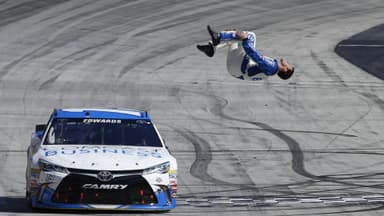The double yellow line rule has been a topic of contention in NASCAR ever since it was introduced to the sport. The same rule was implemented during this Sunday’s postseason opener at Atlanta Motor Speedway as well. Justin Haley was black-flagged as a result of breaking the same and received a penalty during the 2024 Quaker State 400.
Advertisement
But what exactly is the double yellow line rule? Well, it’s quite simple to understand. A driver is not allowed to compete below the two yellow lines that separate the racing surface from the apron. The two lines are most commonly seen on speedway-style tracks such as Daytona, Talladega, and Atlanta.
According to the NASCAR rulebook, a driver cannot cross the yellow lines to gain an advantage or block someone from getting past. Haley blocked Tyler Reddick’s attempt to get past him down the inside but pushed the car too wide over the yellow lines. As a result, he had to start from the back of the pack after the stage break.
The reason why Justin Haley got black flagged pic.twitter.com/Brsfu04qOt
— Skewcar (@Skewcar) September 8, 2024
“NASCAR defines beneath the double yellow lines as follows: when the vehicle’s left side tires are beneath the left line of the inside double yellow lines that separates the apron from the racing surface while passing another vehicle,” the rule goes on to say.
Despite being penalized, Haley did well to come back and finish in P12. The Rick Ware Racing driver has long been touted as one of the best talents in the Cup Series today. With a competitive car behind him, the 25-year-old can become a real championship contender in the future. Had he not been penalized in Atlanta, Haley could have landed a rare top-five finish for his team.
When did the double yellow line rule come into existence?
The rule was brought into the sport in 2001 as a means to improve driver’s safety. After the tragic passing of the late great Dale Earnhardt during the 2001 Daytona 500, NASCAR made several changes to improve safety, both for the driver inside the car, as well as out on the track. One of the changes was introducing the double yellow line rule so that drivers don’t carry too much speed down the apron area of the track.
It was quite contentious at the time as several drivers had won races by going low on the apron and taken the lead. Jeff Gordon’s 1997 Daytona 500 win came exactly like that. Earnhardt had also taken to the bottom of the track on certain occasions to win races. At the time, it was not an uncommon practice.
However, in modern-day NASCAR, doing the same is frowned upon and is often penalized by the governance based on a judgment call taken after analysis of the incident.








